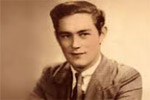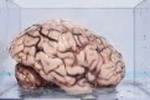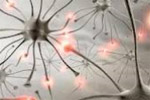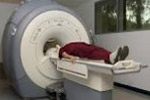Brain Research |
|
Istraživanje mozga |
People with amazing memory

|
|
Ljudi sa zadivljujućim pamćenjem

|
The case of Henry Molaison

|
|
Slučaj Henrya Molaisona

|
Detective work

|
|
Detektivski posao

|
Reliving the past

|
|
Ponovno proživljavanje prošlosti

|
Total recall

|
|
Potpuno sjećanje

|
The emotional arousal theory

|
|
Teorija emocionalnog uzbuđenja

|
The brain scans reveal interesting details

|
|
Snimke mozga otkrivaju zanimljive podatke

|
Can we improve our memory as well?

|
|
Možemo li i mi poboljšati svoje pamćenje?

|
|
|
|
|

People with amazing memory
It was an email that memory researcher James McGaugh found hard to believe.
The sender, a 34-year-old housewife named Jill Price, was claiming that she could recall key events on any date back to when she was about 12, as well as what she herself had done each day.
She wrote: "Some people call me the human calendar, while others run out of the room in fear. But the one reaction I get from everyone who finds out about this gift is – amazement. I run my entire life through my head every day and it drives me crazy".
McGaugh invited Price to his lab, making sure he had to hand a copy of "20th Century Day by Day", a book that lists important events by date.
He opened the book to random pages and asked Price what had happened on those days.
"Whether it was a plane crash or some elections or a movie star doing an outrageous thing, she was dead on, time and time again", he recalls...
 Search for more... Search for more...
It was an email that memory researcher James McGaugh found hard to believe.
The sender, a 34-year-old housewife named Jill Price, was claiming that she could recall key events on any date back to when she was about 12, as well as what she herself had done each day.
She wrote: "Some people call me the human calendar, while others run out of the room in fear. But the one reaction I get from everyone who finds out about this gift is – amazement. I run my entire life through my head every day and it drives me crazy".
McGaugh invited Price to his lab, making sure he had to hand a copy of "20th Century Day by Day", a book that lists important events by date.
He opened the book to random pages and asked Price what had happened on those days.
"Whether it was a plane crash or some elections or a movie star doing an outrageous thing, she was dead on, time and time again", he recalls.
That was in June 2000.
McGaugh's group has worked closely with Price ever since, and has discovered she is one of a select few with similar abilities.
These individuals are neither autistic savants nor masters of mnemonic-based tricks of recall, yet they can remember key events from almost every day of their lives.
Learning more about their abilities and how their brains are wired should lead to insights into the nature of human memory.
Intrigued by McGaugh's findings, I arranged to visit his lab at the University of California, Irvine, to find out how these people live with such unusual abilities - and what it is like for the researchers working with them.
"It never ceases to amaze me", says McGaugh's colleague, Aurora LePort.
"Some of them can remember every day you give them".
She says studying people whose powers of recall seem to be enhanced, rather than impaired, offers us a new tool to explore memory.
» Search for more...
|
|

Ljudi sa zadivljujućim pamćenjem
Bila je to poruka elektroničke pošte u koju je Jamesu McGaughu, istraživaču sposobnosti pamćenja, bilo teško povjerovati.
Poslala ju je 34-godišnja kućanica Jill Price koja je tvrdila da se može prisjetiti datuma svih važnih događaja od svoje 12. godine pa nadalje, ali i svega što je ona radila bilo koji dan.
Napisala je: "Neki ljudi me zovu ljudskim kalendarom, a drugi u strahu bježe iz prostorije. Ali reakcija svakoga tko sazna za ovaj moj dar je – zadivljenost. Svaki dan vrtim u glavi svoj cijeli život i to me izluđuje".
McGaugh je pozvao gđu Price u svoj laboratorij, pobrinuvši se da pri ruci ima primjerak knjige "20th Century Day by Day" u kojoj su po datumima navedeni važni događaji 20. stoljeća.
Nasumično je otvarao knjigu i pitao gđu Price što se događalo tih dana.
"Bez obzira je li bila riječ o padu zrakoplova ili o skandaloznom ponašanju neke filmske zvijezde, njezini su odgovori bili savršeno točni, svaki put", prisjeća se McGaugh...
 Potraži više... Potraži više...
Bila je to poruka elektroničke pošte u koju je Jamesu McGaughu, istraživaču sposobnosti pamćenja, bilo teško povjerovati.
Poslala ju je 34-godišnja kućanica Jill Price koja je tvrdila da se može prisjetiti datuma svih važnih događaja od svoje 12. godine pa nadalje, ali i svega što je ona radila bilo koji dan.
Napisala je: "Neki ljudi me zovu ljudskim kalendarom, a drugi u strahu bježe iz prostorije. Ali reakcija svakoga tko sazna za ovaj moj dar je – zadivljenost. Svaki dan vrtim u glavi svoj cijeli život i to me izluđuje".
McGaugh je pozvao gđu Price u svoj laboratorij, pobrinuvši se da pri ruci ima primjerak knjige "20th Century Day by Day" u kojoj su po datumima navedeni važni događaji 20. stoljeća.
Nasumično je otvarao knjigu i pitao gđu Price što se događalo tih dana.
"Bez obzira je li bila riječ o padu zrakoplova ili o skandaloznom ponašanju neke filmske zvijezde, njezini su odgovori bili savršeno točni, svaki put", prisjeća se McGaugh.
Bilo je to u lipnju 2000. godine.
Otada McGaughov tim blisko surađuje s gđom Price, otkrivši da je ona jedna od nekolicine odabranih sa sličnim sposobnostima.
Ti pojedinci nisu autisti sa sindromom savant ni majstori mnemoničkih trikova s pamćenjem, no ipak se mogu prisjetiti ključnih događaja iz gotovo svih dana svojeg života.
Bolje upoznavanje s njihovim sposobnostima i načinom funkcioniranja njihovih mozgova trebalo bi pomoći u shvaćanju prirode ljudskog pamćenja.
Zaintrigirana McGaughovim otkrićima, dogovorila sam posjet njegovom laboratoriju na Kalifornijskom sveučilištu u Irvineu želeći saznati kako ti ljudi žive s tako neobičnim sposobnostima - i kakvo je to iskustvo za istraživače koji s njima rade.
"Ne mogu se prestati čuditi", kaže McGaughova suradnica Aurora LePort.
"Neki od njih mogu se prisjetiti svakog dana koji im spomenete".
Ona kaže da nam upravo proučavanje ljudi s povećanom, a ne sa smanjenom sposobnošću pamćenja, nudi nove alate za istraživanje pamćenja.
» Potraži više...
|

The case of Henry Molaison
It is certainly fair to say that most of our knowledge of memory derives from looking at memory loss.
The classic case is that of Henry Molaison (better known as "HM"), who had surgery nearly 60 years ago to treat severe epilepsy.
In a misguided attempt to remove the source of the seizures, several parts of the brain were cut out, including both hippocampi, curled up ridges on either side of the brain.
For HM, the consequences were catastrophic.
Although he could still recall his early life, he was no longer able to lay down memories of things that happened to him after the surgery.
Every day, the researchers studying his condition had to introduce themselves anew.
Intriguingly, though, he could perform tasks that used short-term memory, like retaining a phone number for a few minutes...
 Search for more... Search for more...
|
|

Slučaj Henrya Molaisona
Može se reći da većina našega znanja o pamćenju proizlazi iz promatranja gubitka pamćenja.
Klasičan slučaj je onaj Henrya Molaisona (poznatijeg kao "HM"), koji je prije gotovo 60 godina operiran zbog ozbiljne epilepsije.
U pogrešno izvedenom pokušaju uklanjanja izvora epileptičnih napadaja odstranjeno je nekoliko dijelova mozga, uključujući oba hipokampusa.
Za HM-a su posljedice bile katastrofalne.
Iako se još uvijek mogao prisjetiti ranijih dijelova svojeg života, više nije mogao pohranjivati sjećanja na stvari koje su mu se dogodile nakon operacije.
Istraživači koji su proučavali njegovo stanje morali su mu se svaki dan iznova predstavljati.
Zanimljivo je, međutim, da je mogao izvršavati zadatke za koje se koristi kratkotrajno pamćenje, primjerice, mogao je nekoliko minuta zadržati u pamćenju neki telefonski broj...
 Potraži više... Potraži više...
|

Detective work
Naturally, McGaugh's team did not take Price's recollections at face value.
In a routine they have since honed on other individuals, they check facts using subjects' diaries and photo albums, interviews with their families, and online research.
For instance, they might check someone's description of their first home against images on Google Street View and the family photo album.
"Some of them are really good", says LePort.
For instance, one subject claimed she could recall what she was thinking when brushing her teeth on a particular date.
She said: "Oh yes, I was thinking about going to dinner".
I cannot confirm that, but from all the other testing that we have done, I do believe her...
 Search for more... Search for more...
|
|

Detektivski posao
Naravno, McGaughov tim nije uzeo sjećanja gđe Price zdravo za gotovo.
U uobičajenom postupku koji su usavršili na drugim pojedincima, činjenice provjeravaju koristeći se dnevnicima i fotoalbumima ispitanika, razgovarajući s njihovim obiteljima i istražujući na internetu.
Primjerice, ispitanikov opis prve kuće u kojoj je živio mogu usporediti sa slikama na Googleovim mapama i obiteljskim fotoalbumima.
"Neki od njih su jako dobri", kaže LePort.
Na primjer, jedna je ispitanica tvrdila da se može sjetiti o čemu je razmišljala dok je prala zube bilo kojega dana.
Rekla je: "O da, razmišljala sam o odlasku na večeru".
Ne mogu to potvrditi, ali na temelju svih drugih ispitivanja koje smo napravili, ja joj vjerujem...
 Potraži više... Potraži više...
|

Reliving the past
The next one of McGaugh's HSAMers I speak to is more upbeat.
Marilu Henner, an actor who is perhaps best known for her role in the 1980s US TV series Taxi, says her abilities have been invaluable professionally.
"In acting classes, people would ask me how am I able to cry or to laugh so easily. I would be right back at that emotional moment, with all of my senses engaged, looking out through my eyes", she said.
Price also concedes her gift helps in her job -as a religious education coordinator at a synagogue.
"My memory helps me remember anything I need to know about the students", she says.
"And my co-workers know that if they need anything, I will be able to find it".
McGaugh says most HSAMers see their talent in a positive light.
"None of them has said they would wish away the ability if they could", he says.
"When I ask what they do when they have a bad memory, they say they conjure up a happy one".
So how much, exactly, can they remember?
LePort has begun a long-term tracking project to see how their memories might fade over time.
Wondering how my own memory might stack up against their awesome abilities, I volunteer to be one of her control subjects.
When we sit down in a lab room, LePort gets right down to business...
 Search for more... Search for more...
|
|

Ponovno proživljavanje prošlosti
Sljedeći McGaughov HSAMer s kojim sam razgovarala pokazuje više optimizma.
Marilu Henner, glumica koja je vjerojatno najpoznatija po svojoj ulozi u američkoj TV seriji Taxi iz 1980-ih, kaže da su te sposobnosti bile neprocjenjive za njezinu profesiju.
"Na satovima glume, ljudi bi me pitali kako mogu tako lako plakati ili smijati se. Vratila bih se točno u taj emotivni trenutak, sa svim svojim osjetilima, promatrajući ga vlastitim očima", kaže Marilu.
Gđa Price također priznaje da joj je njezin dar pomogao u poslu koordinatorice vjerskog odgoja u sinagogi.
"Pamćenje mi pomaže da se sjetim svega što trebam znati o polaznicima", kaže ona.
"A moji kolege znaju da ću moći pronaći sve što im zatreba".
McGaugh kaže da većina HSAMera promatra svoj talent u pozitivnom svjetlu.
"Nitko od njih nije rekao da bi se odrekao tog dara kada bi mogao", kaže McGaugh.
"Kad ih pitam što rade kad se sjete loših trenutaka, kažu mi da u sjećanje dozovu neki sretan trenutak".
A koliko toga zaista mogu zapamtiti?
LePort je započela dugotrajni projekt praćenja kako bi vidjela mogu li njihova sjećanja izblijedjeti tijekom vremena.
Pitajući se kakvo je moje vlastito pamćenje u usporedbi s njihovim zapanjujućim sposobnostima, ponudila sam da budem jedan od kontrolnih ispitanika.
Kad smo sjele u laboratorij, LePort je odmah prešla na posao...
 Potraži više... Potraži više...
|

Total recall
With the HSAMers, says LePort, it's a different story.
Her initial findings are that, when asked to describe the events of one day a month back, they can recall just under half of the details they provided when interviewed on the day in question.
"But if you compare a month out and then ten years out, the information HSAMers recall is about the same".
In other words, whatever they manage to recall a month later is still fresh in their minds a decade on.
LePort is fascinated by what might be going on in the brain over that first month.
Her hunch is that HSAMers hold on to the gist of a day and lose some of the incidental details.
"It's important to understand that HSAMers do forget", says LePort...
 Search for more... Search for more...
|
|

Potpuno sjećanje
LePort kaže sa je s HSAM-ovima druga priča.
Njezina prva saznanja govore da, kada se od njih zatraži da opišu događaje nekog dana iz proteklog mjeseca, mogu se prisjetiti tek nešto manje od pola detalja koje dali na razgovoru toga dana.
"Ali ako usporedite sjećanje na događaje iz prošlog mjeseca, a zatim sjećanje na događaje od prije 10 godina, HSAM-ovi se prisjećaju otprilike istih podataka".
Drugim riječima, čega god da su se sjećali poslije mjesec dana, toga su se sjećali i nakon deset godina.
LePort je fascinirana procesima koji se možda zbivaju u mozgu tijekom tog prvog mjeseca.
Ona pretpostavlja da HSAM-ovi zadržavaju bit dana, a gube neke usputne detalje.
"Važno je shvatiti da HSAM-ovi zaboravljaju", kaže LePort...
 Potraži više... Potraži više...
|

The emotional arousal theory
That's a theory that Henner subscribes to.
"Since I was a kid, I've tried to fill each day with a certain richness", she says.
"Especially since I'm going to remember it no matter what".
Certainly during my own tests, I find that emotion plays a role in my recall.
Sadly, I am ineligible to continue as one of control subjects, because the week for which I recounted my daily memories included a holiday weekend, which could give me an unfair advantage.
But one month on, I ask a friend to help me recreate the questioning in my living room, and then check the results against LePort's data.
It is quickly apparent that I recall very few of the particulars.
What does come back is not the day-to-day routine but the emotional highs and lows - the fight with my ex, and the bittersweet feelings that accompany my son finishing kindergarten.
The rest remains elusive...
 Search for more... Search for more...
|
|

Teorija emocionalnog uzbuđenja
Tu teoriju prihvaća gđa Henner.
"Otkad sam bila dijete, pokušavala sam svaki dan ispuniti određenim bogatstvom", kaže.
"Naročito zato što ću ih zapamtiti bez obzira na sve".
Svakako sam tijekom vlastitog testiranja shvatila da emocija igra određenu ulogu u mojem pamćenju.
Nažalost, više nisam prikladna za kontrolnog ispitanika, jer je tjedan za koji sam navodila svoja sjećanja uključivao blagdanski vikend, a to mi je moglo dati nepoštenu prednost.
Ali sam za mjesec dana tražila prijatelja da mi pomogne rekonstruirati ispitivanje u mojoj dnevnoj sobi, a zatim da usporedim rezultate s podacima LePort.
Odmah je postalo jasno da se sjećam vrlo malo pojedinosti.
Ono što sam pamtila nije svakodnevna rutina već emocionalni usponi i padovi - svađa s bivšim mužem i gorkoslatki osjećaji koji prate zadnje dane vrtića mojega sina.
Sve ostalo je bilo maglovito...
 Potraži više... Potraži više...
|

The brain scans reveal interesting details
The scans did reveal interesting details of other areas of the brain, though.
To start with, the 11 HSAMers have larger-than-average temporal lobes.
That seems to tie in neatly with the fact that these regions are where we store long-term memories, although McGaugh is quick to point out that we can't assume anatomy is cause rather than effect.
"We don't know if the way they remember makes changes to the brain, or those changes in brain structure result in the way they remember", he says.
There were also differences in the left uncinate fasciculus, a fibrous pathway that connects the hippocampus and amygdala to the frontal cortex and which, when damaged, has been linked to impaired autobiographical memory...
 Search for more... Search for more...
|
|

Snimke mozga otkrivaju zanimljive podatke
Međutim, snimke su otkrile zanimljive podatke o drugim područjima mozga.
Za početak, sljepoočni režnjevi tih 11 HSAM-ova veći su od prosjeka.
To se podudara s činjenicom da se dugotrajno pamćenje pohranjuje u te regije mozga, iako McGaugh brzo ističe da ne možemo pretpostaviti da je anatomija uzrok, a ne posljedica toga.
"Ne znamo mijenja li se njihov mozak zbog načina na koji pamte, ili su te promjene u moždanoj strukturi posljedica načina na koji pamte", kaže McGaugh.
Također su uočene i razlike u bijeloj tvari na lijevoj strani mozga, tj. končaste staze koja spaja hipokampus i amigdalu sa frontalnim korteksom i koja se, ako se ošteti, povezuje sa slabljenjem autobiografskog pamćenja...
 Potraži više... Potraži više...
|

Can we improve our memory as well?
LePort thinks that the HSAMers' obsessive tendencies could be important.
"It may be that a form of unconscious rehearsal is taking place", she says.
Some studies suggest that such rehearsal contributes to the ability to store memories in the long term.
That idea, and the emotional arousal theory, remain hypotheses that need further testing.
None of the research so far has shown a convincing way for those of us with ordinary memories to start replicating the HSAMers' abilities...
 Search for more... Search for more...
|
|

Možemo li i mi poboljšati svoje pamćenje?
LePort misli da opsesivne sklonosti HSAM-ova mogu biti važne.
"Možda se radi o obliku nesvjesne probe", kaže LePort.
Neka istraživanja ukazuju da takva proba pridonosi sposobnosti dugoročnog pohranjivanja sjećanja.
Ta ideja, kao i teorija emocionalnog uzbuđenja, ostaju pretpostavke koje je potrebno dodatno ispitati.
Nijedno dosadašnje istraživanje nije pokazalo uvjerljiv način na koji ljudi s običnim pamćenjem mogu početi kopirati sposobnosti HSAM-ova...
 Potraži više... Potraži više...
|
|
|




